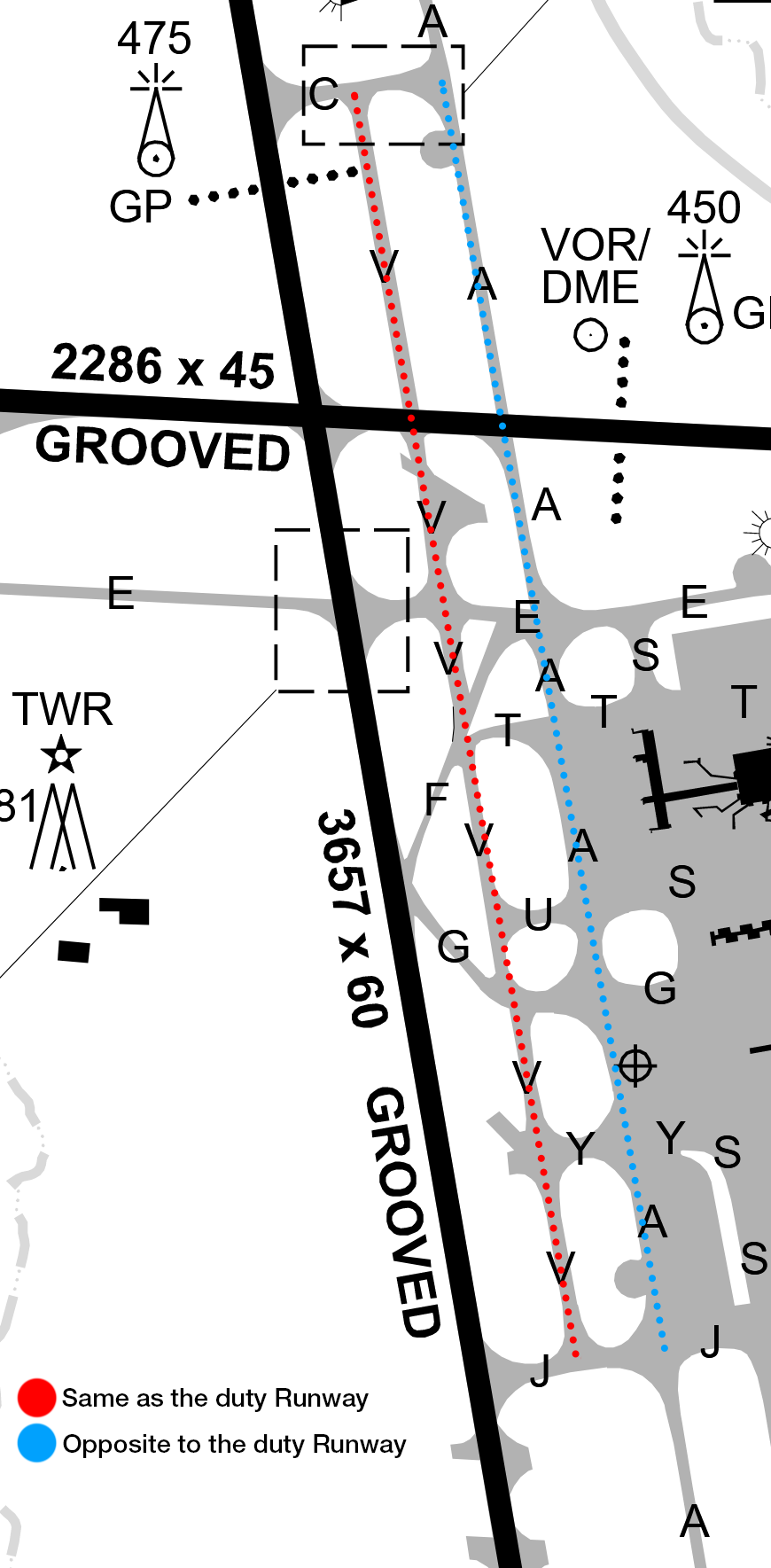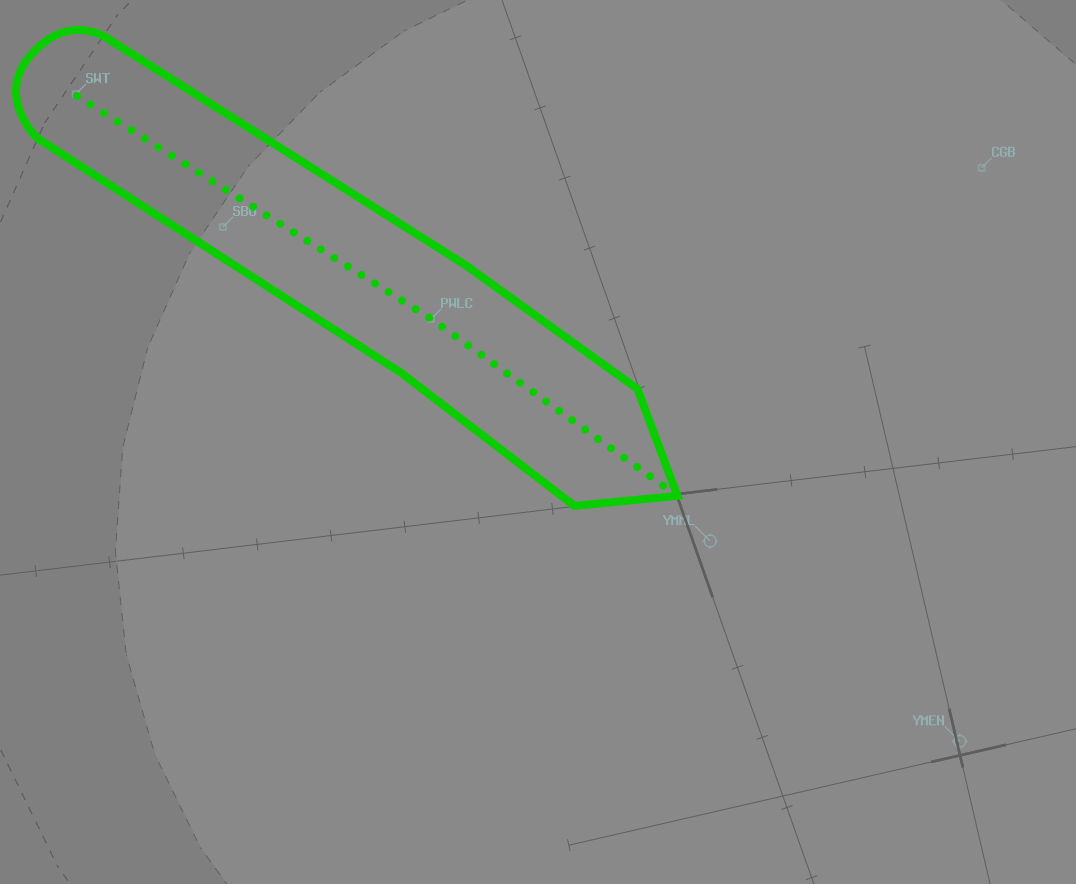Melbourne (YMML)
Positions
| Name | Callsign | Frequency | Login Identifier |
|---|---|---|---|
| Melbourne ADC | Melbourne Tower | 120.500 | ML_TWR |
| Melbourne SMC | Melbourne Ground | 121.700 | ML_GND |
| Melbourne ACD | Melbourne Delivery | 127.200 | ML_DEL |
| Melbourne ATIS | 118.000 | YMML_ATIS |
Standard Taxi Routes
Except when the traffic situation warrants, taxi clearances shall conform to the following diagram:

Airspace
ML ADC is not responsible for any airspace by default.
Runway Modes
If winds are too great, single runway operations may be necessary (eg, Runway 16 for Arrivals and Departures). However, pending wind limitations (Crosswind <20kts, Tailwind <5kts), the following runway modes are to be used
| Mode | Arrivals | Departures |
|---|---|---|
| 27AD/34D | 27 | 34 (Departures NE), 27 (All other deps) |
| 16A/27D | 16 | 27 |
| 09A/16D | 09 | 16 |
Information
"Departures NE" means departures via MNG, NONIX and DOSEL. Runway 34 for departure may also be more suitable during this runway mode for heavy aircraft (due to the length of runway 27), and aircraft taxiing from the southern apron.
Note
See Runway Mode Formatting for details on how to format each runway mode in the ATIS.
SID Selection
Jet Aircraft planned via MNG, NONIX, DOSEL, CORRS, KEPPA, NEVIS, SUNTI, ESDIG, or CRENA, shall be assigned the Procedural SID that terminates at the appropriate waypoint. Jet Aircraft not planned via any of these waypoints shall receive amended routing via the most appropriate SID terminus, unless the pilot indicates they are unable to accept a Procedural SID.
Example
Jet Aircraft planned via DOSEL, assigned runway 27, shall be given the DOSEL SID.
Off Mode Departures
During the 16A27D Runway Mode, some aircraft may operationally require Runway 16 for departure.
Aircraft departing Runway 16 and assigned the Standard Assignable Heading would conflict with departures from Runway 27, so the ISPEG SID must be used instead.
Jet aircraft via MNG, NONIX, DOSEL, KEPPA, NEVIS or ESDIG, using Runway 16 for departure Off Mode, shall be assigned the ISPEG SID.
Definition
Off Mode: Aircraft departing from a runway not prescribed as active for departures on the ATIS. For example, a heavy aircraft that operationally requires Runway 16 for departure during the 16A/27D Mode.
RADAR SID
a) Jet aircraft departing Off Mode that don't meet the above critera; or
b) Non-Jet Aircraft; or
c) All aircraft using Runway 09; or
d) Aircraft that cannot accept a Procedural SID
Shall be assigned the Radar SID.
Example
Non-Jet Aircraft planned via DOSEL, assigned runway 34, shall be given the ML (RADAR) SID.
ATIS
ATIS Identifier
YMML ATIS identifiers only uses letters N through to Y, due to nearby YMEN using letters A through M.
Approach Expectation
With Runway 34 in use for arrivals and the cloud base above A030 but below A042, the APCH field shall include:
ACFT ON THE ALPHA STAR EXP INSTR APCH
This permits controllers to assign aircraft either the Alpha or Victor STAR and process them for a GLS/RNP approach or a visual approach (depending on traffic flow and pilot preference).
Runway Mode formatting
| Mode | ATIS Runway information |
|---|---|
| 27AD/34D | 27 FOR ARR, RWY 34 FOR DEPARTURES N E, RWY 27 FOR ALL OTHER DEPARTURES |
| 16A/27D | 16 FOR ARR, RWY 27 FOR DEPARTURES |
| 09A/16D | 09 FOR ARR, RWY 16 FOR DEPARTURES |
Operational Info
Independent Crossing Runway Operations
When using runway mode 09A/16D, the ATIS OPR INFO shall include:
SIMUL INDEP CROSSING RWY OPS IN PROG
This allows for both Runway 09 and Runway 16 to operate independently of each other, with aircraft departing Runway 16 from Taxiway Echo.
Pushback Request on ACD
The Real-world YMML ATIS will at times include an operational info line:
ALL DEPARTURES MUST REQUEST PUSH BACK ON 127.2
Whilst this is used to reduce frequency congestion on SMC in the real world, coordination limitations in the VATSIM environment mean that this procedure serves no benefit to the SMC and ACD controllers (Instead of SMC having to answer a pushback request from an aircraft, SMC still has to answer a coordination line from ACD regarding an aircraft requesting pushback).
In light of this, the use of this operational info should be avoided.
Miscellaneous
Sunbury Corridor
Day VFR Helicopters may request clearance via the Sunbury Corridor. It is defined as the corridor 1nm either side of a track from SWT - PWLC - 16/27 Intersection at YMML.

Boundary Coordination must be completed to ML TCU for clearances in this airspace
Example
ML ADC -> ML TCU: "For Ident, HM3, Sunbury Corridor, not above A020"
ML TCU -> ML ADC: "HM3, No Restrictions"
Due to the close proximity of the airspace to the arrival and departure paths at YMML, controllers should be aware of surrounding traffic before issuing a clearance to helicopters.
Example
HM3: "Melbourne Tower, HM3, approaching SWT, A020, for YMEN via the Sunbury Corridor, request clearance"
ML ADC: "HM3, cleared to YMEN, track Sunbury Corridor, not above A020"
HM3: "Cleared to YMEN, track Sunbury Corridor, not above A020, HM3"
If necessary, consider issuing a clearance limit for separation or instruct helicopters to report sighting and to maintain own separation with other aircraft. Alternatively, tower controllers can simulate visual separation provided no risk of collision exists and both aircraft remain in sight of the controller at all times.
Example
ML ADC: "HM3, report sighting a Jetstar A320, 4nm final runway 16"
HM3: "Traffic sighted, HM3"
ML ADC: "HM3, pass behind that aircraft, maintain own separation, caution wake turbulence"
HM3: "Pass behind the A320, maintain own separation, HM3"
Remember to pass traffic information to both aircraft.
Example
ML ADC: "JST515, traffic is a helicopter, 2nm northwest of the field, tracking for Essendon and maintaining own separation with you, runway 16, cleared to land"
JST515: "Runway 16, cleared to land, JST515"
Coordination
Auto Release
Important
Melbourne utilises auto release for all Procedural SIDs and the ML (RADAR) SID provided aircraft are assigned the Standard Assignable Level and a Standard Assignable Heading.
'Next' coordination is not required for aircraft that are:
- Assigned a Procedural SID
- Departing from a runway nominated on the ATIS; and
- Assigned
A050
- Assigned the ML (RADAR) SID
- Departing from a runway nominated on the ATIS; and
- Assigned
A050; and - Assigned a Standard Assignable Heading
- Assigned the ISPEG SID
- Departing from Runway 16 during the 16A27D Runway Mode; and
- Assigned
A050; and - Tracking via MNG, NONIX, DOSEL, KEPPA, NEVIS or ESDIG
All other aircraft require a 'Next' call to ML TCU.
Example
ML ADC -> ML TCU: "Next, JIA, runway 34"
ML TCU -> ML ADC: "JIA, Track Extended Centreline, Unrestricted"
ML ADC -> ML TCU: "Track Extended Centreline, JIA"
ML ADC: "JIA, Track Extended Centreline 340 degrees, Runway 34, Cleared for Takeoff"
JIA: "Track Extended Centreline 340 degrees, Runway 34, Cleared for Takeoff, JIA"
The ML TCU controller can suspend/resume Auto Release at any time, with the concurrence of ML ADC.
The Standard Assignable level from ML ADC to ML TCU is the lower of A050 or the RFL.
Standard Assignable Departure Headings
Aircraft that have been cleared the ML (RADAR) SID must receive an assigned heading with their line up or takeoff clearance.
The following Standard Assignable Headings may be used for aircraft assigned the ML (RADAR) SID, depending on their direction of travel.
| Runway | W | NE | SE | S |
|---|---|---|---|---|
| 09* | - | - | - | - |
| 16** | 290 | 290 | 160 | 260 |
| 27 | 320 | 290 | 260 | 260 |
| 34 | 340 | 340 | 340 | 260 |
*When Runway 09 is in use for departures, ML TCU shall nominate a heading to ML ADC for use as a standard assignable heading.
**When Runway 09 is in use for arrivals, all Runway 16 departures shall be assigned heading 160.
Runway Change
Any runway change must be prior coordinated to MAE and EN ADC.
Departures Controller
Refer to Melbourne TCU Airspace Division for information on airspace divisions when MDN and/or MDS are online.
EN ADC
EN ADC is responsible for separation with all YMML traffic, and will coordinate any aircraft operating in EN ADC airspace that cannot be visually or laterally separated with YMML traffic.
Example
EN ADC -> ML ADC: "Boundary Ident, OXG, Published Missed Approach from the ILS 26"
ML ADC -> EN ADC: "OXG, My restriction is QFA451 on a 10nm final RWY 34. Your separation"
EN ADC -> ML ADC: "My separation with QFA451, OXG"